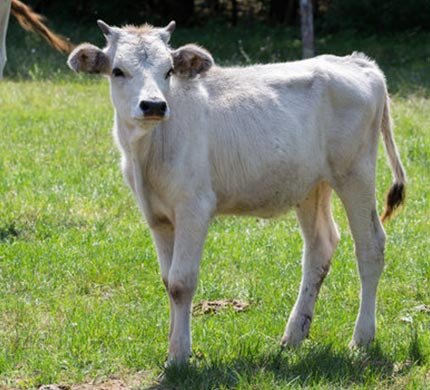Hungarian Grey
- Temperature:5°C and 20°C
- Milk:3-4 liters of milk per day
- Food:Hay, silage
- Pregnancy:Approximately 283 days
- Nationality:Hungarian

General Information
Hungarian Grey, also known as Magyar Szürke, is a breed of cattle that originated in Hungary. It is one of the most important breeds in Hungary, and is widely used for meat, milk, and draught purposes.
Hungarian Grey cattle are a large breed, with cows weighing around 1,100-1,200 pounds and bulls weighing up to 2,000 pounds. They have a distinctive grey or silver coat, which can range from light to dark shades. They also have long, curved horns and a muscular build.
Hungarian Grey cattle are known for their hardiness and adaptability to a variety of climates and environments. They are well-suited to extensive grazing systems and can thrive on poor-quality forage. They are also docile and easy to handle, making them popular among farmers and ranchers.
Where we find this cow to buy?
If you are interested in purchasing Hungarian Grey cattle, it would be best to contact local breeders or agricultural organizations in Hungary or other countries where the breed is found.
You can search online for Hungarian Grey cattle breeders and contact them to inquire about purchasing animals.
It is important to do your research and choose a reputable breeder who can provide you with healthy and genetically sound animals.
You should also ensure that you have the necessary facilities and resources to properly care for the cattle, including adequate grazing land, shelter, and feed.
Alternatively, you may be able to find Hungarian Grey cattle for sale through livestock auctions or classified ads in agricultural publications.
However, it is important to be cautious when purchasing animals through these channels and to thoroughly inspect the animals before making a purchase.

How to increase milk production in Hungarian Grey
Hungarian Grey cattle are known for their high milk production, which can be further increased through various management practices. Here are some tips on how to increase milk production in Hungarian Grey:
01
Ensure that the cows have access to high-quality feed that meets their nutritional requirements. A diet rich in protein, energy, and minerals can increase milk production.
02
Proper management practices such as regular health checks, vaccinations, and deworming can help maintain the health of the cows, which can lead to increased milk production.
03
Proper milking practices are essential to maximize milk production, such as regular intervals, clean environment, and proper maintenance of equipment.
04
Ensure that the cows have comfortable and spacious housing with adequate ventilation and lighting. A comfortable environment can reduce stress and improve milk production.
Medicine
As with any livestock, Hungarian Grey cattle may require veterinary care and medication from time to time to maintain their health and treat any illnesses or injuries. Some common types of medication that may be used to treat Hungarian Grey cattle include:
01
AntibioticsAntibiotics may be used to treat bacterial infections in cattle, such as pneumonia, mastitis, or foot rot.
02
AnthelminticsAnthelmintics are medications used to treat internal parasites that can affect cattle health and productivity.
03
VaccinesVaccines are an important tool for preventing common cattle diseases, such as bovine respiratory disease or infectious bovine rhinotracheitis.
04
Anti-inflammatory drugsAnti-inflammatory drugs may be used to treat conditions such as arthritis, lameness, or injuries.
Pregnancy
Hungarian Grey cows are typically bred through natural mating or artificial insemination. After mating, the fertilized egg begins to develop into an embryo.
The embryo develops into a fetus over 280-290 days, during which time the cow’s uterus will expand to accommodate the growing fetus.
When it is time for the calf to be born, the cow will go into labor. This typically involves strong contractions of the uterus, which push the calf out through the birth canal.
As the cow approaches the end of pregnancy, she may show physical signs such as a swollen udder, increased appetite, and restlessness.
The embryo will travel down the fallopian tube and into the uterus, where it will implant in the uterine lining.
After giving birth, the cow will produce milk for her calf and will need to be monitored closely for any signs of health issues or complications.
Important!
It is important to provide proper nutrition and veterinary care during pregnancy to ensure the health of both the cow and the calf. Good herd management practices can also help to minimize the risk of complications during pregnancy and childbirth.
Food
Hungarian Grey cattle are known for their ability to thrive on roughage and forage-based diets, as they are well adapted to grazing on rugged terrain. Here are some common types of food that are fed to Hungarian Grey cattle:
Grass is a primary source of nutrition for Hungarian Grey cattle. They graze on natural pastures, as well as hay or silage made from grasses.
It is important to provide Hungarian Grey cattle with access to clean water and appropriate mineral supplements to maintain their health and productivity.
Forbs are broadleaf plants that are often found in natural pastures. They are a good source of nutrition for Hungarian Grey cattle and can help provide a varied diet.
In addition to forage, Hungarian Grey cattle may be fed concentrated feeds such as grains, soybean meal, or other protein supplements to meet their nutritional needs.
Facts
Here are some interesting facts about Hungarian Grey cattle:
Hungarian Grey cattle are a breed of cattle that originated in Hungary. They are also known as Magyar Szürke in Hungarian.
Hungarian Grey cattle are also used for milk production, although their milk yield is generally lower than other dairy breeds.
Hungarian Grey cattle are endangered, but efforts are underway to preserve them and promote sustainable agriculture.
Hungarian Grey cattle are an important part of Hungarian culture and history, depicted in art and literature.
Medium-sized, medium-sized cattle with a distinctive grey coat and muscular build, suited to grazing in rough terrain.
This cattle are adapted to the harsh climate and terrain of Hungary, providing access to roughage sources.
Hungarian Grey cattle are known for their high-quality meat, tender, flavorful, and low in fat.
Cattle were traditionally used for draft purposes, such as plowing fields and hauling carts.